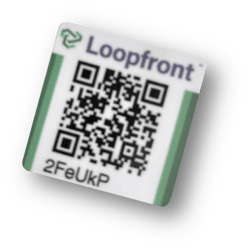Keep overview with QR-codes
QR codes link the physical object to the digital registration in Loopfront. This is how you get the best overview for maintaining your inventory!

Benefits of using QR codes to get successful overview:
- Clear labeling of what has been surveyed. Avoid double registration of the same object and incorrect ammount of items in your inventory.
- Easily see if a physical object is available or ordered by someone else.
- Find the correct placement for misplaced objects.
- Get an overview of QR-marked objects in floor plans and easily move materials.
- Find a specific individual object if your Inventory consists of many similar items on the same floor / location that may have been moved after surveying.
- Be able to distinguish between individual objects with individual variations if you have several similar products in your inventory and update information (placement, condition, need for repair etc..)
- Easier for operations teams and movers to coordinate when everything is QR-coded instead of having to check who is going to move what and and when.
- Keep physical control of what goes where in order-processes and make sure to move the correct object that has been ordered, if you have several orders to many different locations.
- Recommended if you run a storage and expect objects (especially furniture) to return to the storage over time and go through more than one reuse cycle.
The platform supports linking QR codes to objects at any time, as long as the functionality is included in your organization's license.
Check if you have access to the QR function: Go to your organization's settings (at the bottom of the menu on the left in Loopfront), go to the "Features" tab and look for the button described below. Don't see the QR button in the list of features, but are interested in testing out the feature? Let us know, and we can send you a few QR-codes by mail.
Contact us for a free trial of the QR-feature

- Recommended for daily operation, overview and maintenance of loose inventory: if your organization is going to map objects in several locations and wants several people in the organization (e.g. operations manager in each building) to be able to easily update information in the platform if some objects are moved, given away or thrown away.
- Recommended for construction or renovation projects: If surveyed objects are likely to stay in the same location where they were surveyed over time (eg windows, doors or other objects that cannot be easily moved physically). You can attach QR code during surveying, and use the QR codes to update information about location in case of future moving or storing.
- NOTE: QR codes are linked to a single object at a time, and are therefore not relevant when surveying larger volumes of individual objects surveyed in meters or square metres, such as ceiling- or flooring tiles.
By linking QR codes to surveyed objects, you can find the material card in Loopfront by scanning the code and be able to easily update information and status of the object.
In other words, choosing when to attach QR codes can vary, depending on the needs of your organization:
- Labeling during surveying
- Labeling after surveying
Attach a QR code during surveying
Attach QR-codes or assign individual ID-numbers to an existing material
Note:
If there is a high risk of objects being moved around a floor or location in the time between surveying and moving / selling - remember to scan the QR code to check if the placement is correct and move the object where it should be placed . If the object has been physically moved to a new location, scan the code and update current placement.
Tip!
Have a discussion in your organization before the surveying starts to make sure you have enough time before the QR codes must be ordered:
- Is the number of objects that will be surveyed so large that it may become more time-consuming to update digital data on an ongoing basis, than adding QR labels at a later time?
- Let a well-thought-out cost/benefit assessment be the basis for choosing when to apply QR codes!
How to order QR-stickers
The Loopfront QR-scanner can only read QR codes that have been generated for use in the platform. Individual ID numbers can be any reference number relevant to your organisation.
Order QR labels 1-2 weeks in advance of surveying. Loopfront has printing partners in several countries who supply durable labels.
Get an overview of QR-marked objects in floor plans and easily move materials.
If you have access to the QR and floor plan functionality in Loopfront, you can use the QR scanner to easily see the location of the material in the floor plan.
1. Go to the Loopfront menu on your mobile device. Click on "Scan QR Code"
2. Scan the QR-code or enter the code at the bottom of the sticker manually


3. Here you will find the material linked to the scanned QR code. If you clik on "view location" you will be able to see the material's current placement in the floor plan.


4. To move the material to another location, go back and click on "move location"
5. Select the location and floor you want to move the material to. Here you can also set precise placement in the floor plan. If the material is being moved to be reused, check the box for "count savings" to include the savings in your reports.


6. That's it! Now the material has been moved to the new placement which you will be able to see the next time you scan its QR code.